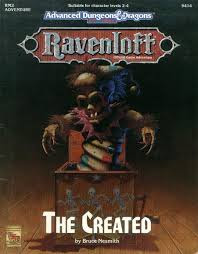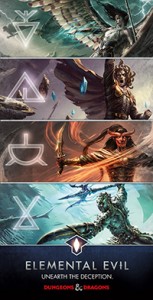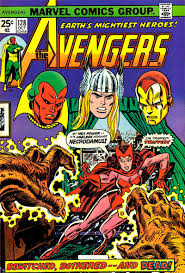Last year, I wrote about an adventure for AD&D 2 for my Favorite Published Adventure. Has it changed since then? Yes, but you’ll see why in a moment. (Provided, of course, I manage to write about that before this goes live.) Take it away, last year me:
Another easy one for me: Bruce Nesmith’s The Created, adventure RM2 with the big RAVENLOFT logo for AD&D 2nd edition.
 It really doesn’t make sense for TSR to publish this adventure the way they did. The Created is marketed as a Ravenloft product, but it really isn’t: the adventurers ride through mists (the standard way to enter that campaign) in a town, are trapped in a mini-domain, defeat the evil mastermind, and the mini-domain returns to the real campaign setting. It’s more of a Ravenloft one-shot. If you were running a Ravenloft campaign, you might pick this up because it’s a Ravenloft module, but then you really can’t use it as written. If you weren’t running a RL campaign, you’d never pick this up. So it doesn’t make much business sense to publish this adventure, but honestly, not much of what TSR did, either. ((Zing!))
It really doesn’t make sense for TSR to publish this adventure the way they did. The Created is marketed as a Ravenloft product, but it really isn’t: the adventurers ride through mists (the standard way to enter that campaign) in a town, are trapped in a mini-domain, defeat the evil mastermind, and the mini-domain returns to the real campaign setting. It’s more of a Ravenloft one-shot. If you were running a Ravenloft campaign, you might pick this up because it’s a Ravenloft module, but then you really can’t use it as written. If you weren’t running a RL campaign, you’d never pick this up. So it doesn’t make much business sense to publish this adventure, but honestly, not much of what TSR did, either. ((Zing!))
Most of the Ravenloft adventures are simple D&D takes on other stories: Adam’s Wrath has roots in Shelley’s Frankenstein, Hour of the Knife is based on Jack the Ripper, Night of the Walking Dead is based on Night of the Living Dead.
The Created is Pinocchio.
Herein the plot, spoiled for your entertainment:
The adventurers enter a town, there’s a murder! Suddenly mists close in and the center of town becomes a mini-domain in Ravenloft! Egad!
This is really cool – the map has color-coded wraparound edges. Continue on the street this way and you come back into the map down this way. Leave the town square heading south, away from the house where the murder happens and you wind up walking right by the murder house. Suitably unnerving. There is no way out until the domain master, our evil Pinocchio, is put down.
For he wants to be a real boy! And he doesn’t care who he has to kill to do it!
There’s a forced capture of all the player characters by the marionettes at the halfway point, and their bodies are switched. It’s railroading, but the destination is Funtown. Suddenly, the players have characters that are only four inches tall, and they’ve got to escape the toymaker’s shop, avoiding the other evil animated toys and the cat.
That damned cat.
Find their bodies, reverse the spell, and kill a wooden boy that would be blood and flesh.
A grand night of fun for all.
So what’s this year’s favorite published adventure?
Princes of the Apocalypse by Sasquatch Game Studio and Wizards of the Coast. Princes is amazing–it’s not only a cool campaign, it’s a gazetteer for an entire region of the Sword Coast. Heck, you could use this book to create your own campaign that doesn’t have anything to do with the Elemental Evil storyline. Sure, there’s a Temple to crawl through, but there’s so much more all over the Dessarin Valley.
 The book is part of what Wizards of the Coasts calls “storylines”. This, the tabletop adventure component of the Elemental Evil storyline, is similar to Paizo’s Adventure Path products where they have a grand tabletop adventure split across six books. Princes of the Apocalypse has the entire adventure in one book. But it’s a really neat adventure the way it is set up. The campaign structure provides a framework for the Elemental Evil cults to react to the hero’s meddling: instead of waiting for the adventurers to find them, the cults are constantly working and plotting. Your heroes might think that they’re doing well, but once they climb out of a temple’s ruins, they might find… well, let’s just drop the name of a rather potent magical item and let your imaginations run wild: devastation orb.
The book is part of what Wizards of the Coasts calls “storylines”. This, the tabletop adventure component of the Elemental Evil storyline, is similar to Paizo’s Adventure Path products where they have a grand tabletop adventure split across six books. Princes of the Apocalypse has the entire adventure in one book. But it’s a really neat adventure the way it is set up. The campaign structure provides a framework for the Elemental Evil cults to react to the hero’s meddling: instead of waiting for the adventurers to find them, the cults are constantly working and plotting. Your heroes might think that they’re doing well, but once they climb out of a temple’s ruins, they might find… well, let’s just drop the name of a rather potent magical item and let your imaginations run wild: devastation orb.
While the adventure is really suggested for 3rd level characters and there are several hooks for bringing characters from the Starter Set’s Lost Mine of Phandalin (which I highly recommend as your first post-Dungeon Master’s Guide purchase if for nothing more than having the Starter Set Rulebook available for quick rules references), the “Alarums and Excursions†chapter is a great starting point for lower-level adventurers of any class. The initial township the PCs begin in have several locations with cues for low-level adventure hooks and the main campaign’s, which will help get your players invested in the town. ((This paragraph lifted from my review of the product at Purple Pawn))
Sasquatch did a bang-up job with this product. It’s interesting about WotC’s collaboration process for their storylines. Everything seems to be farmed out to other studios: Kobold Press took care of the Hoard of the Dragon Queen/Rise of Tiamat adventure for the first storyline, while Green Ronin is coming up with the Out of the Abyss adventure for the next storyline. Gale Force 9 has been doing the DM Screens for the storylines. I’m not sure how much input WotC is having on these products other than guidance and approvals.
Oh, and Mike Schley’s maps are amazing. Go and buy them.
 Back in high school, I played a few Supers RPGs like Champions and Villains & Vigilantes, but despite the characters wearing their underwear on the outside, they never felt like they were actual scenes from a comic book. Marvel Heroic does.
Back in high school, I played a few Supers RPGs like Champions and Villains & Vigilantes, but despite the characters wearing their underwear on the outside, they never felt like they were actual scenes from a comic book. Marvel Heroic does.

